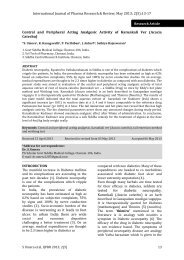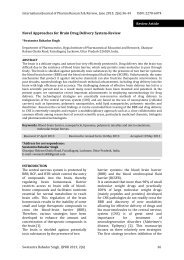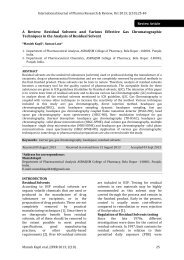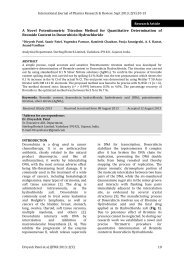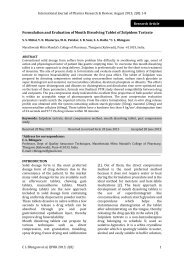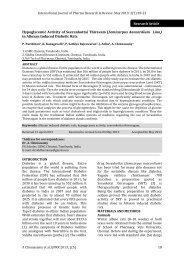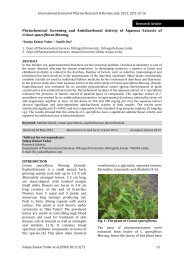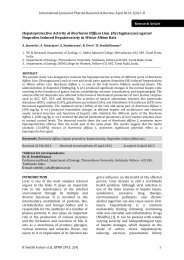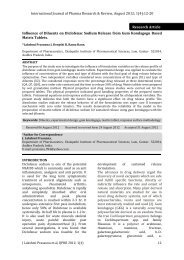Formulation and Evaluation of Herbal Antidandruff Shampoo ...
Formulation and Evaluation of Herbal Antidandruff Shampoo ...
Formulation and Evaluation of Herbal Antidandruff Shampoo ...
- No tags were found...
You also want an ePaper? Increase the reach of your titles
YUMPU automatically turns print PDFs into web optimized ePapers that Google loves.
International Journal <strong>of</strong> Pharma Research & Review, Oct 2013; 2(10):12-24Table 2: Composition <strong>of</strong> Antid<strong>and</strong>ruff shampoo containing allicin loaded SLNsIngredientsAllicin-SLNs(%)Lemon Oil(%)PeppermintOil (%)SLS(%)CMC(%)EDTA(%)ColourSH-SLNs1SH-SLNs2SH-SLNs3SH-SLNs4SH-SLNs5SH-SLNs6SH-SLNs7SH-SLNs86 6 6 6 6 6 6 6 65 4 4 3.5 4 4 3 4 35 5 5 4.5 4 5 4 4 4SH-SLNs957 58 58 59 59 59 60 60 6110.5 9 7.5 8.5 8 10 9.5 10 91 2.5 4 3 3.5 0.5 2 0.5 1.5LightPinkLightPinkLightPinkLightPinkLightPinkLightPinkLightPinkLightPinkLightPinkPerfume Q.S Q.S Q.S Q.S Q.S Q.S Q.S Q.S Q.SSaturated Q.S Q.S Q.S Q.S Q.S Q.S Q.S Q.S Q.SNaclSolutionWater Q.S Q.S Q.S Q.S Q.S Q.S Q.S Q.S Q.S<strong>Evaluation</strong> <strong>of</strong> Allicin loaded solid lipidnanoparticles:a).Measurement <strong>of</strong> zeta potential,particle size <strong>and</strong> poly dispersity index.By using Zetasizer, zeta potential weremeasured .In this method the samples werediluted with aqueous solution to get 50-200kcps <strong>and</strong> pH <strong>of</strong> sample from ranges 6.9-7.2. Zeta potential measurement wascarried at 25 0 C, <strong>and</strong> the electric fieldstrength was 23.2V/cm[14, 15].b) Scanning Electron Microscopy (SEM)The SEM analysis <strong>of</strong> prepared allicin loadedSLN was performed for morphologicalstudies. The formulations were placed in tocircular aluminium stubs using doubleadhesive tape <strong>and</strong> coated with gold in HUS -5 GB vacuum evaporator then it wasobserved in Hitachi S-3000 N SEM havingacceleration voltage <strong>of</strong> 10 Kv <strong>and</strong> amagnification <strong>of</strong> 5000X .[14,15]c) Entrapment efficiencyThe Entrapment efficiency <strong>of</strong> preparedSLNs was determined by measuring theconcentration <strong>of</strong> free drug in a dispersionmedium. It was carried out at least 2 weekafter preparation due to crystallization. Itwas determined by adding 1 ml <strong>of</strong> nanosuspensionin to 4 ml <strong>of</strong> water. Thencentrifuged it for 90 min at 15,000 rpm.Then supernants were examined by UV/Visspectrophotometer with further dilution inwater at 324 nm. The amount <strong>of</strong> free drugwas detected in the filtrate <strong>and</strong> the amount<strong>of</strong> incorporated drug was determined as aresult <strong>of</strong> the initial drug minus. Theentrapment efficiency was calculated by[15, 16].%Entrapment efficiency = W (TOTAL DRUG-FREE DRUG) /W (TOTAL DRUG ADDED) × 100.d) In-vitro drug release <strong>of</strong> allicin loadedSLNs:The in vitro release <strong>of</strong> allicin from differentSLNs dispersions was determined using thedialysis bag diffusion technique. Dialysisbag consists <strong>of</strong> 12,000-14,000 MW cut-<strong>of</strong>f.Prior to the experiment, the membrane waswashed with warm Milli-pore doubledistilled water (70°C) for 1 hrs <strong>and</strong> thenrinsed thrice with Milli-pore water toremove the glycerine. 6 mL <strong>of</strong> suspensionwere placed inside the dialysis bag, tied atNeeta Rai et.al, IJPRR 2013; 2(10) 15



